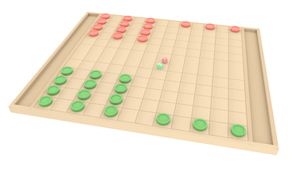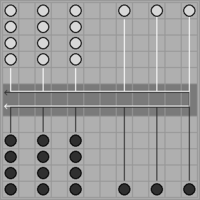Gedvas
 Starting position for Gedvas on an 12×12 board, with two dice having the numbers 1-6 | |
| Years active | at least 1,000 |
|---|---|
| Genre(s) | Board game Abstract strategy game Mind sport |
| Players | 2 |
| Setup time | <1 minute |
| Playing time | 30 minutes – 2 hours |
| Random chance | Medium (dice rolling) |
| Skill(s) required | Strategy, tactics, counting, probability |
Gedvas is a popular kind of board game found mainly in Vosan, which involves two players moving a set of uniform cylindrical game pieces across a 12×12 board and capturing by jumping onto opponent pieces. While some state Gedvas as originating from an ancient Ohanian board game called Qakakun, this is disputed and likely not true.
Unlike other board games similar to it, this game relies on luck and features six-sided dice used by both players. For this reason, it is sometimes called amuro vucuna or "Dice Vucuna," but this is a misnomer given the completely different style of play.
Rules
Gedvas is played by two opponents, on opposite sides of the gameboard. One player has the dark pieces; the other has the light pieces. Players alternate turns. A player may not move an opponent's piece. A move consists of rolling a die and moving the number of spaces read on the die to a valid space, if possible. If the space a piece moves to has a single draught belonging to an opponent, the piece landed on will be captured and removed from play.
Setup
Gedvas is played on a 12×11 board, with the middle row, known as the (Vosan gedibas gedibas), or "warzone," being twice as long as the others. Of the twelve columns, six of them, the first, third, and fifth from either side, are occupied with draughts, with the first, third, and fifth columns from the "near half" having four spaces occupied by draughts and the space closest to the warzone empty, and the first, third, and fifth columns from the "far half" having the spaces in each column closest to the player have one draught each, and the rest of the spaces vacant. Typically, to the side of the board there are containers to either side that hold the eliminated pieces and the pieces that completed their journey.
Movement
To start the game, each player rolls their die, and the player with the higher number moves first using the number shown on their die. If the players roll the same number, they must roll again. Both dice must land completely flat on the right-hand side of the gameboard. The players then take alternate turns, rolling one die at the beginning of each turn.
After rolling the die, players must, if possible, move their checkers according to the number shown on the die. However, there are situations where the player is unable to move:
- If the number rolled exceeds that of which a draught needs to either enter or exit the warzone
- If the number rolled would put the draught on top of a fortress.
If the number shown on the player's die is enough for their draught to occupy the same space as an opponent's draught, they may capture that draught and remove it from the game. This may happen if a draught enters the warzone via a space an opponent draught is on.
Going Home
Endgame
The game ends once all of a player's draughts are off the board, whether by being captured or going home. If a player has gotten more draughts home by the end of the game than their opponent, they win the game.
Naming
Gedvas's name comes from a mutation of the Vosan word gedibas, meaning "warzone."
